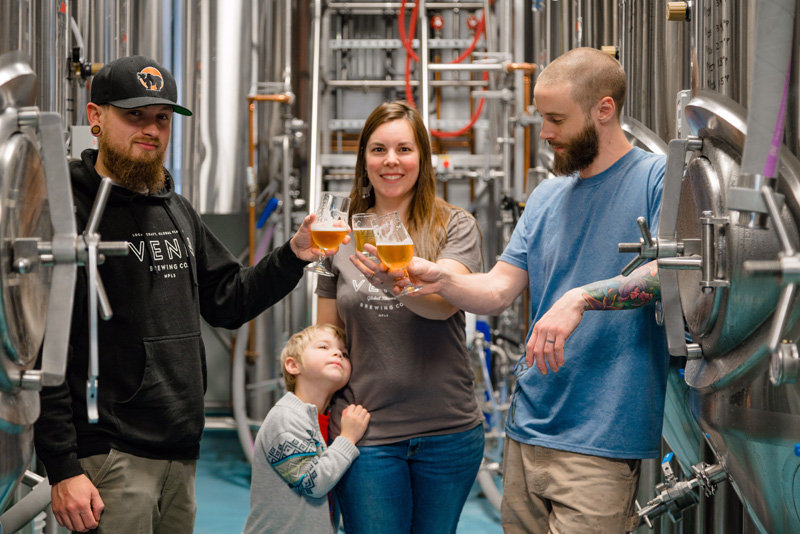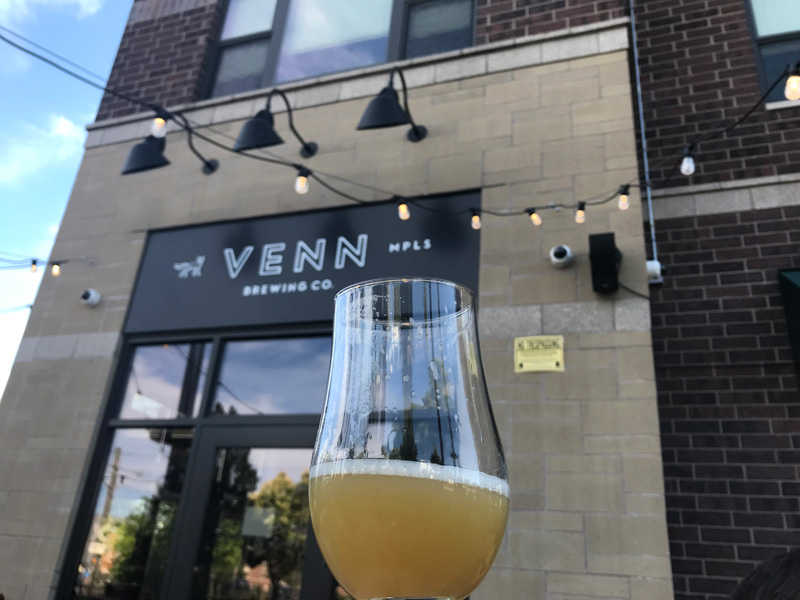This story originally appeared in the Heavy Table’s Tulip and Schooner newsletter, which tells the stories of beer, wine, and spirits in the Upper Midwest. Get the newsletter (and three others) by backing Heavy Table on Patreon.
Venn Brewing opened during the winter of 2017-2018 in a uniquely urban setting adjacent to the Metro Transit’s 46th Street Station in Minneapolis. Patrons have come to expect a rotating lineup of beer styles with a view of the Blue Line and a busy Hiawatha Avenue just beyond the patio fence.
While Venn quickly connected with its community, the brewery started expanding their reach this year. We caught up with co-owner Kyle Sisco (pictured below right with brewer Ben Michaels, CMO Connie Sisco, and Jason Sisco) to talk about the evolving business and their core identity.
This interview has been edited for clarity.
HEAVY TABLE: You’ve started canning and entering new markets. How’s that going?

KYLE SISCO: It’s going really well. The switch from Crowlers to 16-ounce cans is something we were planning but it was also imposed by changes in the market, changes in the law. And Crowlers had always been a limitation for our distribution program. It’s not a format that everybody is a fan of, myself included. Switching to 16-ounce cans was the pathway for growing, kind of born out of necessity.
HT: When did you start thinking about distribution?
KS: When we opened, the taproom was definitely our focus and it still is in many ways. Distribution was never the focus of the business plan but if we’re able to make more beer than the taproom consumes, we’d be dumb not to do something with it.
After getting comfortable in the taproom, it became the obvious next step. We dabbled in it pretty carefully with Elevated as our exclusive retail account for Crowlers until we figured out how to do it and it gradually expanded from there.
HT: I imagine you don’t have much room to grow the brewhouse in this building?
KS: We were out of space in pretty much every regard the day we opened. There is no room to add tanks or to make them taller. We’ve had to get creative with storage.
Any growth we’ve wanted to pursue beyond the production capacity that exists here, we’ve had to daydream about finding it somewhere else. Probably 2018-2019 we looked at a small facility to do some barrel aging, things like that, but it was never financially sustainable.
HT: You’re brewing and canning offsite?
KS: Yes and no.
Anything that’s brewed here gets canned here. I would guess 25-30% — not by brand but by volume — gets canned at the taproom. That’s more of the one-off stuff. The core brands are done at Insight: Northodox, Chronicopia, the Cosmosis sours, Venn Pils, and Insight has a canning line that we use.
HT: Are people buying different beers in stores than in the taproom?
KS: We’re still figuring those trends out. It’s steadily growing but we’re trying to throttle it so it’s manageable, something that we can achieve with the resources and people that we’ve got. Really fast growth has never been a goal of mine. I want to make sure that it’s sustainable and that we’re not killing our people in the process.

HT: You’re focusing on core brands for distribution whereas you opened [the taproom] with a constant flux of beers.
KS: Very early in the distribution expansion we were still focusing on variety and that worked well with the liquor stores we partnered with until this expansion. But as we brought on more accounts, it became clear very quickly that the majority of stores outside the craft beer focused stores don’t like rotating SKUs. When it’s out, they order more and put it back in the same spot. It’s been a shift from a philosophy standpoint (from focusing on variety to focusing on consistency) but that’s the name of the game in distribution.
HT: I’ve observed the core brands, and even branding, establishing itself over time.
KS: When you start to fine tune some of the [recipes] and stop doing them as one-offs, it only makes sense to brand them. Northodox was the first beer to get branded and it really started to establish our brand identity. And that was just because there are lots of breweries that effectively rebrand the same beer with different hops on a constant basis. We didn’t feel the need to reinvent it and sell it as something new each time. That’s true for West Coast IPA, fruited sours…Once you settle onto something good, give it an identity that people can come back to over and over again.
HT: What is your reach with distribution now?
KS: We had originally kept within the 694/494 loop but we’re well outside of that now: as far north as Andover, as far south as Lakeville, as far west as Chaska/Chanhassen, and as far east as Woodbury. Covering most of the 7-county metro but the vast majority of our stores are still in Minneapolis/Saint Paul.
HT: Did you find that being open for a while helped with name recognition or reputation?
KS: Not at all. The vast majority of the accounts we’ve brought on since we started brewing at Insight had no idea who we were. And for a relatively good reason: we had never approached them.
HT: Have you observed any changes in your identity or perception now that you’re distributing?
KS: In the grand scheme of producing and distributing we’re still really small. Historically we do about 1,000 barrels per year out of our taproom. Schell’s and Summit do over 100,000. The medium-sized craft breweries are in the 15,000-20,000 range. Even with distribution this year we’ll probably do 2,000 – maybe 2,500. There are breweries that opened and did that right out of the gate.
I’m hoping we can continue to grow distribution without losing the essence of the taproom. Our taproom is a bit of a departure from a standard brewery that has a focus on distribution because most of those companies are opening in a warehouse in an industrial district that are not conducive to neighborhood taprooms. A lot of those breweries have the good fortune of a single facility that serves both their taproom and their distribution. It’s the downside of having a location that does focus on residential. In a neighborhood, the facilities for efficient production and distribution don’t exist so we have to work in two facilities.
HT: It sounds, in a sense, that this growth was your plan all along?
KS: It wasn’t. Candidly, Connie and I and our business partner Jedd [Taylor] thought that the taproom was the extent for the business.
Connie and I would have left it alone. The taproom has been successful: it’s predictable and comfortable and we feel good about it. But our staff – many of which have been with us since day one – they’re the reason we are where we are today and they wanted more to do.
Ben [Michaels], our head brewer, is really proud of the beers that we produce and he wants to share them with the world. The collective opinion of our staff to expand is really the motivation behind what we’re doing. It’s not what Connie and I wanted to do, personally, but to ignore the input from the people who made us what we are would be pretty self-centered and dismissive.
HT: I would say that the southside Minneapolis breweries aren’t as well-known as some other areas. They’re a little more neighborhood focused and, while they have distribution, it’s not huge. Do you think the southside is overlooked by the Minnesota beer scene?
KS: Not within the southside, and that’s what we like about it. There’s a lot of Southside pride among the breweries here and a lot of camaraderie too. It may be true that, outside of the Southside, folks are not as aware of us as they are the breweries in Northeast, etc.
HT: It’s not as dense.
KS: That was intentional for us. We wanted to focus on the neighborhood and we wanted the neighborhood to focus on us: a mutual relationship. I would not change that for the world. If the distribution thing doesn’t work out for some reason, we’ll contract and continue to operate as a taproom brewery and have no hard feelings about it.
HT: How do coffee and THC drinks fit into Venn’s identity?
KS: THC has been instrumental in the distribution expansion. We started doing it as soon as we knew it was an option, on a small scale out of the taproom. But demand for it has been overwhelming.
Because there were (at least at the time) fewer regulatory hurdles to make a THC beverage (which is kind of mindblowing), we were able to start making THC at the production facility sooner than we were able to start making beer. That was a stepping stone, learning how to do THC beverage on a larger scale before we transitioned to beer. The enthusiasm around it as a new product has been huge for the bottom line and the expenses. It was still very expensive to get [distribution] off the ground and THC helped us finance the whole thing.
Coffee has been a huge success bringing people in during the day. Our taproom sat unused for the better part of each morning and afternoon. All in all, it’s been great to be able to offer the majority of the public’s social drugs of choice. Between caffeine and THC and alcohol, there’s something for everybody. [Laughs.]
HT: How do you view Venn’s identity today as compared to day one?
KS: I don’t look at it any differently today, to be honest.
We’re still fundamentally the same group of people that started in the beginning. We’re just doing more with what we’ve got. We still value employees over profit. I don’t think that selling more beer means we become a different company. People may know more about us and more people may know of us – which is great — but I also don’t think awareness and popularity has any influence on who we are. People may see us differently but we don’t see ourselves differently.
